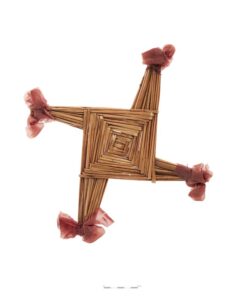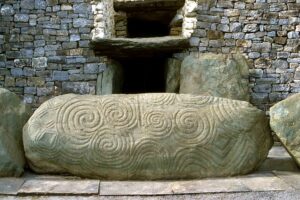St Brigid’s Cross
Cathy Koos
Ushering in February are a couple more ancient traditions. Besides the curious custom of yanking Phil the Groundhog out of his burrow on February 2, the Irish weave St. Brigid’s Crosses on that same day.

Figure 1 National Museum of Ireland, collection
The patron saint of midwives, farmers, and fugitives, it is likely more an adaptation of the more ancient goddess Brigid, and thereby bringing her followers into the new church’s fold when it arrived on Ireland’s shores around 450 CE.
Traditionally made from the same rush as a thatched roof, the crosses are tucked up in the rafters above the cottage door to assure continued protection from hunger and fire for the coming year. Some rush crosses are the typical 4-armed style woven around a center diamond or lozenge. However, the arms are set at an angle, giving it a almost spinning design. Another less common design is the triskele, a mash-up of ancient, triple, interconnected spirals like we see at many neolithic sites around the world.

Figure 2 Newgrange, courtesy Heritage Ireland
If you’d like to try your hand at weaving your own Brigid’s cross, here is a great YouTube from the National Museum of Ireland: